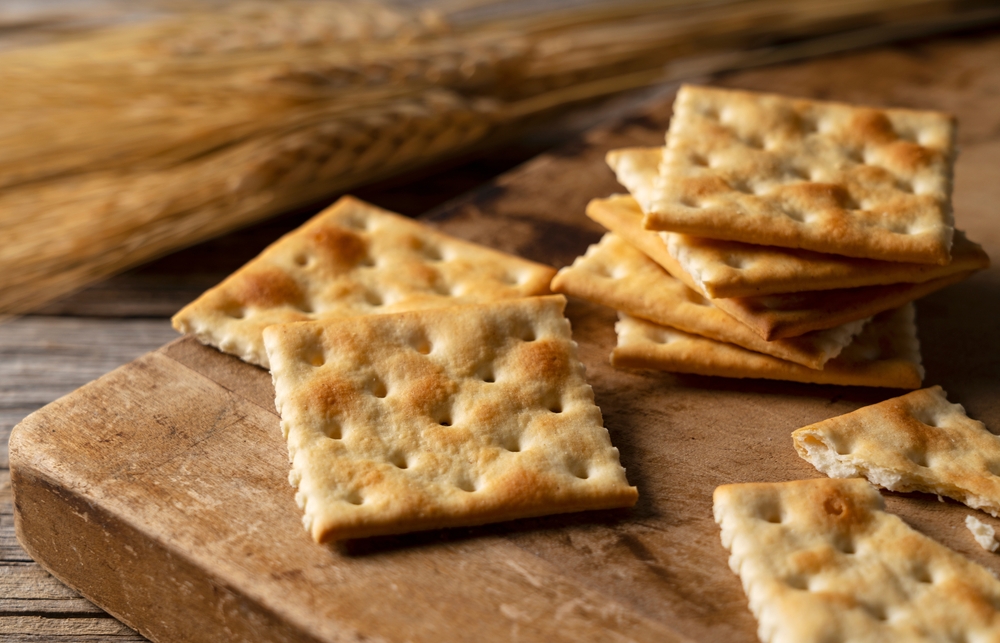Saltine crackers aren’t a weight-loss food.
They’re low in fiber and protein, made from refined flour, and pack a lot of calories for their weight—so they won’t keep you full for long.
Keep reading to see exactly why they fall short and how you can still fit them into a fat-loss plan if you want.
Understanding What’s in a Saltine
Think of a saltine as a small, light cracker that delivers quick carbs with very little staying power.
To set clear expectations, here’s what you’re actually eating in typical portions and why that matters for fullness.
- Per cracker (~3 g): ~13 kcal, ~2.2 g carbs, ~0.28 g protein, ~0.26 g fat, ~0.08 g fiber, ~28 mg sodium.
- 5 crackers (~15 g): ~65 kcal, ~11 g carbs, ~1.4 g protein, ~1.3 g fat, ~0.4 g fiber, ~141 mg sodium.
- 10 crackers (~30 g): ~130 kcal, ~22 g carbs, ~2.8 g protein, ~2.6 g fat, ~0.8 g fiber, ~282 mg sodium.
These numbers show a pattern you can feel when you snack: lots of carbohydrate with almost no fiber or protein.
That combo digests fast and doesn’t create much fullness, especially compared with options that deliver more fiber and protein per calorie (for example, Greek yogurt with berries or an apple with peanut butter).
Energy density adds another wrinkle. A saltine sits at ~4.33 kcal per gram (13 ÷ 3), which is high; foods with that kind of calorie density pack more energy into less weight and volume.
Lower–energy-density foods—think water- and fiber-rich choices like vegetables, soups, beans, and many fruits—take up more space in your stomach for the same calories, so you feel satisfied sooner and stay full longer.
The flour matters, too.
Standard saltines are made from refined white flour, which strips away most fiber and some of the grain’s natural structure.
That refined base means minimal nutritional complexity and a faster digesting starch profile, so hunger tends to return sooner.
Sodium isn’t the main story for fat loss, but it’s worth keeping an eye on: the math adds up quickly if you snack straight from the sleeve (roughly 38 crackers), landing you near ~498 kcal and ~1,080 mg sodium before you realize it.
If you plan to include saltines, treat them as a small, counted carb side rather than the core of a snack—then bring the satiety with protein and produce.
Why Saltines Don’t Actively Support Fat Loss
Saltines look light, but their nutrition profile works against steady appetite control.
You get quick carbs with very little fiber or protein, which means you’re hungry again soon after you eat them.
Saltiety is the first issue.
Per cracker, most of the calories come from starch, while fiber and protein barely register.
That mix doesn’t hold in your stomach or slow digestion much, so fullness fades fast.
When a snack doesn’t keep you satisfied, you tend to reach for more food sooner, which makes staying in a calorie deficit harder than it needs to be.
Energy density adds to the problem.
Saltines sit at about 4.33 kcal per gram, a level where foods pack a lot of calories into a small, airy volume.
Diet patterns that lean on higher–energy-density items often lead to higher total intake because you can eat a lot of calories before your stomach senses enough weight and bulk.
In contrast, lower–energy-density foods—such as fruit, vegetables, broth-based soups, and beans—bring water and fiber that take up space for fewer calories, helping you feel satisfied on less food.
The refined-flour base works against satiety, too.
Saltines are made from white flour, and many refined crackers test as high–glycemic foods.
Not every saltine brand has been formally tested, but the pattern is clear: fast-digesting, low-fiber staples tend to spike and drop blood glucose more quickly, which often pairs with a quicker return of hunger and more nibbling later.
None of this makes saltines inherently “fattening.”
Fat loss still comes down to a consistent calorie deficit.
The point is simpler: saltines don’t help you create that deficit because they offer little fullness per calorie.
If you like them, you can still make them work with a few guardrails: cap a serving at about 5 crackers (~65 kcal) as a small carb side, don’t snack straight from the sleeve, and pair them with protein and produce (for example, tuna or cottage cheese plus cucumber).
Whole-grain or unsalted-top versions can shave some sodium and add a touch of fiber, but they remain crackers—use them sparingly and with a plan.
The Sodium Factor

Sodium isn’t about fat gain, but it can nudge the scale and your blood pressure.
With saltines, the totals climb faster than you think if you snack without measuring.
- Per cracker: ~28 mg sodium
- 5 crackers: ~141 mg
- 10 crackers: ~282 mg
- One sleeve (~38 crackers): ~1,080 mg
Those amounts matter against typical daily targets.
Most adults are advised to keep sodium around 2,000–2,300 mg per day.
A single sleeve can eat up roughly half that budget, and even a few casual handfuls can push your day higher than planned.
Extra sodium pulls water into your bloodstream and tissues, so your weight may jump for a day or two even when your calories are on point.
That’s water, not fat, but it can make progress harder to read and may raise blood pressure if high intakes become routine.
Use a few simple guardrails.
Decide your portion before you open the box and plate it out—think 5 crackers (~141 mg sodium) as a small side or 10 (~282 mg) only if the rest of the meal is low in sodium.
Prefer unsalted tops when you can; they trim the number without changing your plan.
If you had a salty meal earlier, balance the rest of the day with lower-sodium choices (for example, fresh produce, grilled lean protein, plain rice or potatoes).
Log your intake so the totals don’t sneak up on you, and weigh yourself at the same time each morning to avoid confusion from day-to-day water shifts.
If you have hypertension or you’re salt sensitive, be stricter and discuss targets with your clinician.
Better-Than-Nothing Choices Within the Saltine Category
If you like the crunch and want the least unhelpful version, you have two small upgrades: unsalted tops and whole-grain saltines.
They don’t fix the satiety problem, but they can reduce sodium a bit and nudge fiber up.
Unsalted tops are the simplest swap.
You get the same calories and macros as standard saltines, just with less added salt on the surface.
That helps keep daily sodium in check and reduces the “scale bounce” from water retention, especially if you’re prone to salty snacks.
The texture and use case stay the same: they’re still quick carbs with very little protein or fiber, so fullness won’t improve in a noticeable way.
Whole-grain versions are a modest improvement on paper.
When “whole wheat flour” is listed first, you typically pick up a little more fiber than the standard refined flour version.
That can help slightly with fullness, but it’s still a dry, low-moisture cracker with high energy density.
In practice, you won’t get the same satiety you’d see from genuinely higher-fiber, water-rich foods like fruit, vegetables, beans, or intact grains.
Think of whole-grain saltines as a marginally better pick within the cracker aisle—not a tool for fat loss.
If you’re choosing among boxes, use a quick label check to stack small wins without overthinking it:
- Look for “whole wheat flour” as the first ingredient on whole-grain boxes.
- Compare fiber per serving and pick the higher one (even if the gain is small).
- Check sodium and favor unsalted tops when available.
- Keep portions intentional (plate ~5 crackers as a carb side) and pair with protein and produce to cover the satiety gaps.
Bottom line: these swaps are incremental upgrades, not game changers.
They make saltines a little less unhelpful, but they still work best as a small, planned carb side—not the star of your snack.
How to Include Saltines Without Sabotaging Your Deficit
You can keep saltines in your plan if you treat them like a small, counted carb—not a standalone snack.
The goal is to control portions, place them inside balanced meals, and add the fullness they lack.
Start with a hard portion cap.
Decide the number before you open the box and plate that amount.
Five crackers ≈ ~65 kcal works well as a carb side; ten ≈ ~130 kcal pushes into snack territory and usually needs help from protein and vegetables to keep you full.
Free-pouring is where trouble starts: a sleeve is roughly ~498 kcal and ~1,080 mg sodium, which can blow up both your daily calories and your sodium target without much satiety.
Use saltines as a side, not the main event.
Fold them into meals that already have lean protein and produce so the crackers add texture rather than carry the calorie load.
For example, pair five crackers with a tuna salad over mixed greens, a bowl of cottage cheese and tomatoes, or a broth-based soup plus a big salad.
If you want ten crackers, trade off another starch in the meal (such as half the rice or some dressing) to keep calories level.
Pair for satiety every time.
Protein and fiber solve the “fast-digesting” problem and help you stop at the portion you planned. Practical combos:
- 5–8 crackers + tuna in water (salt, pepper, lemon) with cucumber rounds.
- 5 crackers + ½ cup cottage cheese with cherry tomatoes and cracked pepper.
- 5 crackers + 2–3 tbsp hummus with carrot sticks and bell pepper strips.
Make it easy to stick to. Pre-bag 5–8 cracker portions, log them when you plate them, and eat seated rather than grazing.
If you’re hungry again soon, add volume foods (greens, broth-based soup, raw veggies) and a clear protein anchor next time instead of adding more crackers.
When Saltines Can Be Useful
Saltines aren’t built for fullness, yet there are moments when a light, quick carb is exactly what you need.
Think short windows where comfort, tolerance, and speed matter more than staying power.
They shine when your stomach is touchy or you need easy-on-the-gut fuel.
For instance, a small portion before training can settle nerves and top up glycogen without heaviness—5–8 crackers (~65–100 kcal) about 20–40 minutes before a workout often sits well if gels or fruit feel rough.
The same logic applies on queasy days, travel days, or during appetite slumps: a few crackers can help you get something down so you can eat a real meal later.
During illness recovery or motion sickness, their plain taste and low residue can make them a workable bridge to normal eating.
None of this changes their low fiber and protein; it only makes them practical in narrow contexts.
Use them with a plan so they don’t crowd out better choices.
Keep portions modest, choose unsalted tops when possible, and pair a later meal with lean protein and produce to backfill the satiety you skipped earlier.
If you use ~10 crackers (~130 kcal) before training, balance the day by trimming another starch elsewhere or adding extra vegetables at dinner.
Sodium can add up, so hydrate and keep the rest of the day’s salty items in check.
Pre-portion into small bags, log the serving when you plate it, and avoid grazing from the sleeve.
Handled this way, saltines can be a convenient tool for very specific jobs—pre-workout tolerance, gentle reintroduction to food, or a quick carb when appetite is off.
They’re not a weight-loss tool, but they can be part of a balanced plan if you work around their weaknesses.
Conclusion
Saltine crackers aren’t a weight-loss food, and they don’t keep you full because they’re low in fiber and protein with high energy density.
They can still fit your deficit if you pre-portion small servings, pick unsalted or whole-grain versions, and pair them with protein and produce.
Use them strategically—as a quick, bland carb—rather than a default snack.







